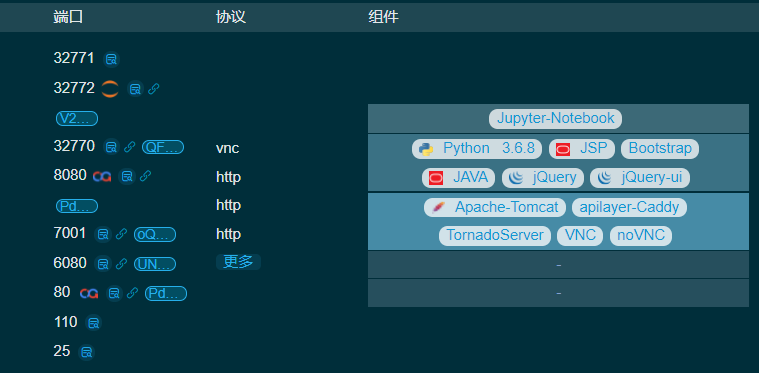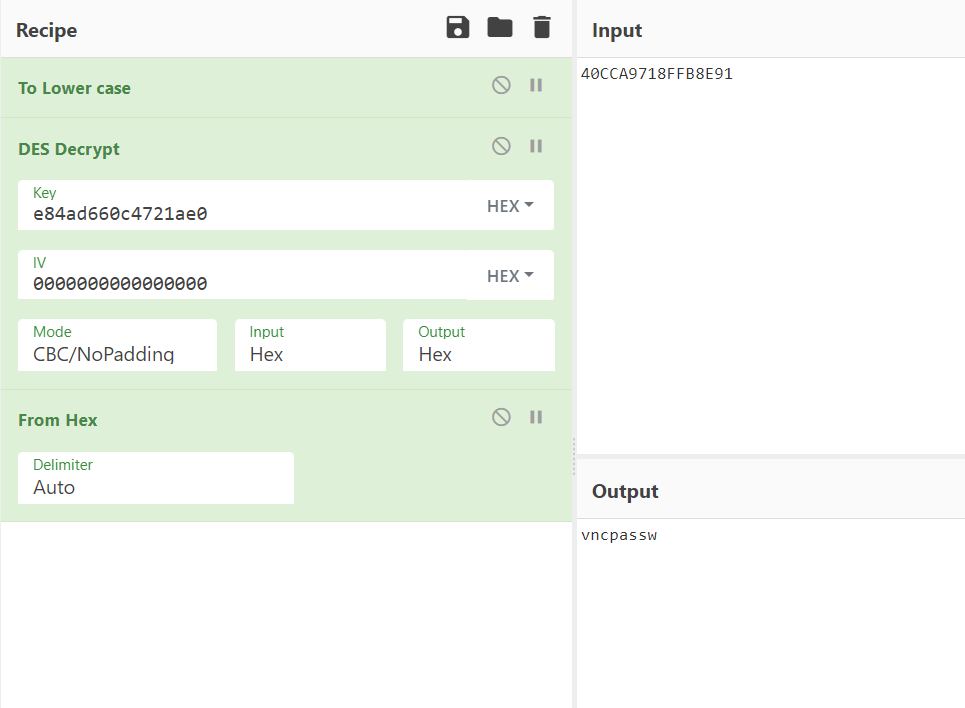CourseGrading 希冀平台VNC密码
希冀是开放、可扩展的信息类专业教学、实验与科研一体化平台。该平台会在32770端口开VNC服务,32771端口为noVNC服务。本文记录一下破解该VNC密码的过程。

通过查看进程,可以得知学生实验机都开了VNC。
搜索该脚本所在位置
root@cg:~/Desktop# find / -name "vnc_startup.sh"
/dockerstartup/vnc_startup.sh
进一步查看脚本内容
root@cg:~/Desktop# cat /dockerstartup/vnc_startup.sh
#!/bin/bash
### every exit != 0 fails the script
set -e
## print out help
help (){
echo "
USAGE:
docker run -it -p 6901:6901 -p 5901:5901 consol/<image>:<tag> <option>
IMAGES:
consol/ubuntu-xfce-vnc
consol/centos-xfce-vnc
consol/ubuntu-icewm-vnc
consol/centos-icewm-vnc
TAGS:
latest stable version of branch 'master'
dev current development version of branch 'dev'
OPTIONS:
-w, --wait (default) keeps the UI and the vncserver up until SIGINT or SIGTERM will received
-s, --skip skip the vnc startup and just execute the assigned command.
example: docker run consol/centos-xfce-vnc --skip bash
-d, --debug enables more detailed startup output
e.g. 'docker run consol/centos-xfce-vnc --debug bash'
-h, --help print out this help
Fore more information see: https://github.com/ConSol/docker-headless-vnc-container
"
}
if [[ $1 =~ -h|--help ]]; then
help
exit 0
fi
# should also source $STARTUPDIR/generate_container_user
source $HOME/.bashrc
# add `--skip` to startup args, to skip the VNC startup procedure
if [[ $1 =~ -s|--skip ]]; then
echo -e "\n\n------------------ SKIP VNC STARTUP -----------------"
echo -e "\n\n------------------ EXECUTE COMMAND ------------------"
echo "Executing command: '${@:2}'"
exec "${@:2}"
fi
if [[ $1 =~ -d|--debug ]]; then
echo -e "\n\n------------------ DEBUG VNC STARTUP -----------------"
export DEBUG=true
fi
## correct forwarding of shutdown signal
cleanup () {
kill -s SIGTERM $!
exit 0
}
trap cleanup SIGINT SIGTERM
## write correct window size to chrome properties
$STARTUPDIR/chrome-init.sh
## resolve_vnc_connection
VNC_IP=$(hostname -i)
## change vnc password
echo -e "\n------------------ change VNC password ------------------"
# first entry is control, second is view (if only one is valid for both)
mkdir -p "$HOME/.vnc"
PASSWD_PATH="$HOME/.vnc/passwd"
if [[ -f $PASSWD_PATH ]]; then
echo -e "\n--------- purging existing VNC password settings ---------"
rm -f $PASSWD_PATH
fi
if [[ $VNC_VIEW_ONLY == "true" ]]; then
echo "start VNC server in VIEW ONLY mode!"
#create random pw to prevent access
echo $(head /dev/urandom | tr -dc A-Za-z0-9 | head -c 20) | vncpasswd -f > $PASSWD_PATH
fi
echo "$VNC_PW" | vncpasswd -f >> $PASSWD_PATH
chmod 600 $PASSWD_PATH
## start vncserver and noVNC webclient
echo -e "\n------------------ start noVNC ----------------------------"
if [[ $DEBUG == true ]]; then echo "$NO_VNC_HOME/utils/launch.sh --vnc localhost:$VNC_PORT --listen $NO_VNC_PORT"; fi
$NO_VNC_HOME/utils/launch.sh --vnc localhost:$VNC_PORT --listen $NO_VNC_PORT &> $STARTUPDIR/no_vnc_startup.log &
PID_SUB=$!
echo -e "\n------------------ start VNC server ------------------------"
echo "remove old vnc locks to be a reattachable container"
vncserver -kill $DISPLAY &> $STARTUPDIR/vnc_startup.log \
|| rm -rfv /tmp/.X*-lock /tmp/.X11-unix &> $STARTUPDIR/vnc_startup.log \
|| echo "no locks present"
echo -e "start vncserver with param: VNC_COL_DEPTH=$VNC_COL_DEPTH, VNC_RESOLUTION=$VNC_RESOLUTION\n..."
if [[ $DEBUG == true ]]; then echo "vncserver $DISPLAY -depth $VNC_COL_DEPTH -geometry $VNC_RESOLUTION"; fi
vncserver $DISPLAY -depth $VNC_COL_DEPTH -geometry $VNC_RESOLUTION &> $STARTUPDIR/no_vnc_startup.log
echo -e "start window manager\n..."
$HOME/wm_startup.sh &> $STARTUPDIR/wm_startup.log
## log connect options
echo -e "\n\n------------------ VNC environment started ------------------"
echo -e "\nVNCSERVER started on DISPLAY= $DISPLAY \n\t=> connect via VNC viewer with $VNC_IP:$VNC_PORT"
echo -e "\nnoVNC HTML client started:\n\t=> connect via http://$VNC_IP:$NO_VNC_PORT/?password=...\n"
if [[ $DEBUG == true ]] || [[ $1 =~ -t|--tail-log ]]; then
echo -e "\n------------------ $HOME/.vnc/*$DISPLAY.log ------------------"
# if option `-t` or `--tail-log` block the execution and tail the VNC log
tail -f $STARTUPDIR/*.log $HOME/.vnc/*$DISPLAY.log
fi
if [ -z "$1" ] || [[ $1 =~ -w|--wait ]]; then
wait $PID_SUB
else
# unknown option ==> call command
echo -e "\n\n------------------ EXECUTE COMMAND ------------------"
echo "Executing command: '$@'"
exec "$@"
fi
很乱,但是可以看到里面有/.vnc/passwd字段,推测就是密码存放位置。
最终在/headless/.vnc/passwd目录下找到了密码文件,密码是通过DES-CBC-NoPadding加密后的
Key为e84ad660c4721ae0,IV为0000000000000000。

可以去开一台makefile的学生机进行编译,免去了环境配置时间。
https://github.com/jeroennijhof/vncpwd
root@cg:~/Desktop# make && chmod +x ./vncpwd && ./vncpwd /headless/.vnc/passwd
Password: vncpassw
https://github.com/billchaison/VNCDecrypt
root@cg:~/Desktop# echo -n 40CCA9718FFB8E91 | xxd -r -p | openssl enc -des-cbc --nopad --nosalt -K e84ad660c4721ae0 -iv 0000000000000000 -d -provider legacy -provider default | hexdump -Cv
00000000 76 6e 63 70 61 73 73 77 |vncpassw|
00000008
得到密码: vncpassw,该密码为所有学生机VNC密码,也为平台在32770的VNC服务的密码。